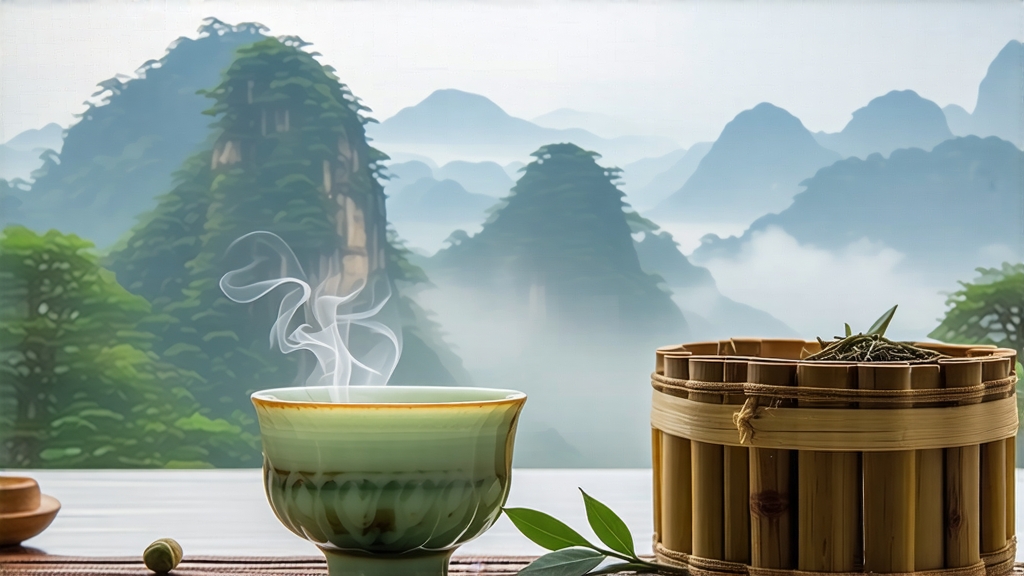
Tucked high on the northern rim of the Sichuan Basin, where perennial cloud banks roll across ancient forests of bamboo and camphor, lies Mengding Mountain—legendary birthplace of the world’s first cultivated tea garden. At 1 450 m above sea level the air is cool, humidity hovers at 85 %, and the soil is a loose, slightly acidic yellow loam laced with quartz sand. These conditions coax the local small-leaf tea arboretum to hoard amino acids and fragrant volatiles, creating the raw material for Mengding Huangya, the most revered yellow tea in China and once the exclusive “morning elixir” of Tang-dynasty emperors.
Historical scrolls kept in the mountain’s Ganlu Temple record that the monk Wu Lizhen planted seven tea bushes here in 53 BCE, presenting the spring harvest to Emperor Han Xuan as “immortal dew.” By the Tang period (618-907 CE) the tea had become an imperial tribute; Song emperor Huizong even decreed that only virgins with golden scissors could pick the buds, believing their touch preserved celestial purity. After centuries of fame the craft nearly vanished during the wartime chaos of the 1930s-40s, surviving only because three elderly monks secretly passed the technique to a local farmer named Yang Tianjie. In 1958 the Sichuan government re-established a state-run workshop on Mengding, and today every kilogram of authentic Mengding Huangya still comes from those original seven mother bushes’ clonal offspring, now protected as a living cultural relic.
Mengding Huangya belongs to the “bud yellow tea” sub-category, meaning it is made exclusively from the unopened bud, sometimes with half of the first leaf still folded inside like a tiny sword in its sheath. Picking occurs during a ten-day window around Qingming festival when the bud reaches 1.5–2 cm, is plump like a grain of rice, and carries 200–220 mg/g of water-extractable solids. Workers climb the terraced slopes at dawn, wearing bamboo hats and cotton gloves to avoid hand-oil contamination; the leaf must reach the village workshop within two hours before enzymatic browning sets in.
The hallmark of yellow tea is “smothering” (men huang), a slow oxidative rest that edges the leaf past green tea’s grassy vibrancy into a mellower, umami-rich profile without ever reaching the darkness of black tea. Mengding Huangya’s craft is a six-act choreography:
- Kill-green at 140 °C for 90 seconds in a shallow iron wok, just enough to denature polyphenol oxidase while preserving a 10 % residual activity.
- Initial roll for 3 minutes under 2 kg pressure to break cell walls and release amino acids.
- First smothering: the still-hot buds are wrapped in three layers—moist calico, then a thin sheet of Mengding bamboo bark, finally a hemp blanket—creating a 38 °C, 75 % RH micro-ferment. Every 40 minutes the bundle is unwrapped and gently shaken to redistribute moisture; this cycle repeats eight times through the night.
- Low-temperature desiccation at 60 °C on a bamboo tray above a charcoal bed of local Qinggang wood; moisture drops to 20 %.
- Second smothering, identical to the first but lasting only four cycles, coaxing a subtle golden tinge to the bud tip.
- Final drying with a hair-dryer-like brass basket whose mouth is covered by fine silk; the tea master listens for the “cricket sound” when buds rattle, indicating 5 % moisture.
The entire process spans 72 attentive hours and reduces 5 kg of fresh buds to 1 kg of finished tea. Because the smothering steps are labor-intensive and demand perfect timing, annual production rarely exceeds 800 kg, making Mengding Huangya rarer per ounce than silver.
Dry leaves resemble slender golden needles, straight and uniform, with a downy white pubescence that catches light like frost. Infused, they stand upright in the glass, slowly pirouetting in a liquor the color of chardonnay. The aroma is a layered triad: fresh corn milk, mountain orchid, and a faint hint of toasted sesame. On the palate it opens with a velvety sweetness reminiscent of raw cashew, shifts to a brothy umami akin to kombu dashi, and finishes with a cool, camphor-like menthol sensation that ling